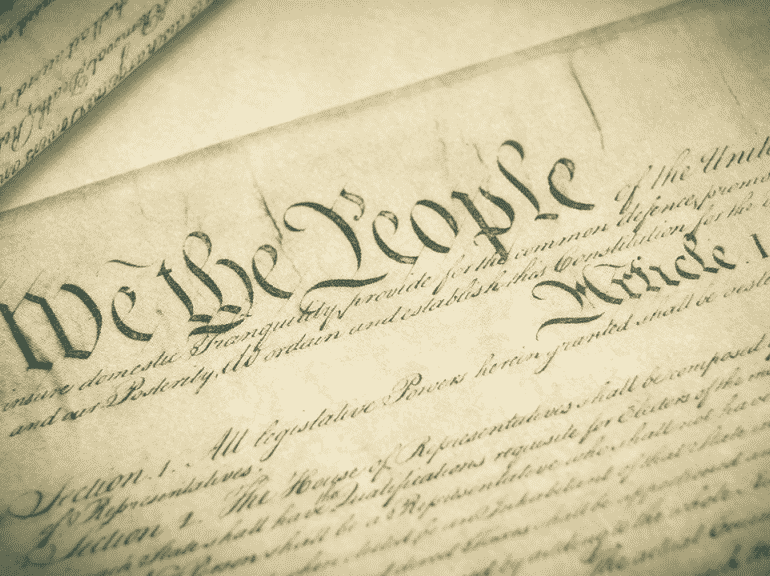
Today in History: New York Ratifies the Constitution
By: Mike Maharrey
On this date in 1788, New York became the 11th state to ratify the Constitution.
The Constitution narrowly won approval by a 30-27 vote on July 26, 1788, after a long, hotly contested debate.
Technically, the Constitution was already in effect. New Hampshire ratified over a month earlier on June 21, becoming the requisite ninth state for “the Establishment of this Constitution between the States so ratifying the Same,” set forth in Article 7. But without ratification by New York and Virginia, most historians believe the Constitution would have never gone into practical effect.
Alexander Hamilton led the federalist supporters of ratification. He was the only member of the New York delegation to the Philadelphia Convention to sign the Constitution. He inked his signature on the document despite the fact that he walked out of the convention early on in proceedings when it became clear that he was not going to get the strong national government he yearned for. After that, Hamilton only appeared sporadically during the proceedings, but he became a staunch advocate for ratification.
George Clinton led the anti-federalists in opposition to the Constitution. Clinton was the governor of New York and served in the Continental Army during the American Revolution despite holding that office. Many speculate that Clinton wrote essays opposing ratification under the pseudonym Cato.
The state held an election to select delegates in late April 1788 and the ratifying convention convened in mid-June 1788.
Knowing the importance of New York ratification, federalists launched a full-press publicity campaign to solidify popular support for ratification. The New York Packet and The Independent Journal published the famous Federalist Papers to this end. The essays were reprinted in other papers throughout New York, as well as in newspapers in a few other states. Hamilton organized the project and enlisted the help of James Madison and John Jay.
Meanwhile, Claxton and Babcock printed special copies of the Constitution and distributed them throughout the state between February 11 and March 21. Claxton and Babcock also published The Federalist Herald. On April 7, 1788, the paper published an editorial marking the local distribution of these copies of the Constitution.
“Before their arrival, you might here behold the honest, uninformed (or rather misinformed) peasantry almost ready to fight that MONSTER, the Constitution; — but, happy event! Their fears are daily vanishing — and their political sentiments are quite different from what they were while kept in the dark.”
The federalists prevailed, but New York insisted on amendments as a condition of ratification. After approving the Constitution, the convention voted unanimously to draft and distribute a circular letter to the other states, appealing for the support of a second general convention to consider amendments. John Jay drafted the letter and it was sent out on July 26.
“We members of the Convention of this State, have deliberately & maturely considered the Constitution proposed for the united States. Several articles in it appear so exceptionable [to a majority of us], that nothing but the fullest confidence of obtaining a Revision of them by a general convention, and an invincible Reluctance to separating from our Sister States could have prevailed upon [a sufficient number] to ratify it [without stipulating for previous amendments]. We all unite in opinion that such a Revision will be necessary to recommend it to the approbation and Support of a numerous Body of our constituents.…”
Following the lead of Massachusetts, New York produced a lengthy ratification document outlining its understanding of the constitutional compact and proposing a number of specific amendments. The document wasn’t legally binding, but it provides important insight into the ratifiers’ intent.
Significantly, the New York ratifiers made it crystal clear that they believed they were delegating the new general government limited powers that they had a right to take back.
“The Powers of Government may be reassumed by the People, whensoever it shall become necessary to their Happiness; that every Power, Jurisdiction and right, which is not by the said Constitution clearly delegated to the Congress of the United States, or the departments of the Government thereof, remains to the People of the several States, or to their respective State Governments to whom they may have granted the same; And that those Clauses in the said Constitution, which declare, that Congress shall not have or exercise certain Powers, do not imply that Congress is entitled to any Powers not given by the said Constitution; but such Clauses are to be construed either as exceptions to certain specified Powers, or as inserted merely for greater Caution.”